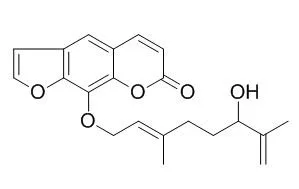METHODS AND RESULTS:
Glycosides, clausenosides A and B, and carbazole alkaloids, clausenaline A, claulamine A, and claulamine B, together with 50 known compounds, were isolated from the stems of Clausena lansium. Their structures were determined by means of spectroscopic methods, including that of CD and 1D/2D NMR analysis. Claulamine A has a 1-oxygenated carbazole skeleton with a rare 2,3-lactone ring, and claulamine B represents an hitherto unknown acetal carbazole alkaloid. Thirty-one of the isolated known compounds were evaluated in various assays for anti-inflammatory activity. Among them, imperatorin, isoheraclenin, and osthol exhibited selective and potent inhibition of formyl-l-methionyl-l-leucyl-l-phenylalanine/cytochalasin B (fMLP/CB)-induced superoxide anion generation, and Lansiumarin C also decreased nitric oxide (NO) and tumor necrosis factor-α (TNF-α) production in lipopolysaccharide (LPS)-induced macrophages. In addition, a modified HPLC method of pre-column derivatization was developed that is more practical for simultaneous analysis of aldose enantiomers as compared to the literature method.
CONCLUSIONS:
The absolute configurations of the sugar moieties in clausenosides A and B were determined with this modified method. |






 Cell. 2018 Jan 11;172(1-2):249-261.e12. doi: 10.1016/j.cell.2017.12.019.IF=36.216(2019)
Cell. 2018 Jan 11;172(1-2):249-261.e12. doi: 10.1016/j.cell.2017.12.019.IF=36.216(2019) Cell Metab. 2020 Mar 3;31(3):534-548.e5. doi: 10.1016/j.cmet.2020.01.002.IF=22.415(2019)
Cell Metab. 2020 Mar 3;31(3):534-548.e5. doi: 10.1016/j.cmet.2020.01.002.IF=22.415(2019) Mol Cell. 2017 Nov 16;68(4):673-685.e6. doi: 10.1016/j.molcel.2017.10.022.IF=14.548(2019)
Mol Cell. 2017 Nov 16;68(4):673-685.e6. doi: 10.1016/j.molcel.2017.10.022.IF=14.548(2019)